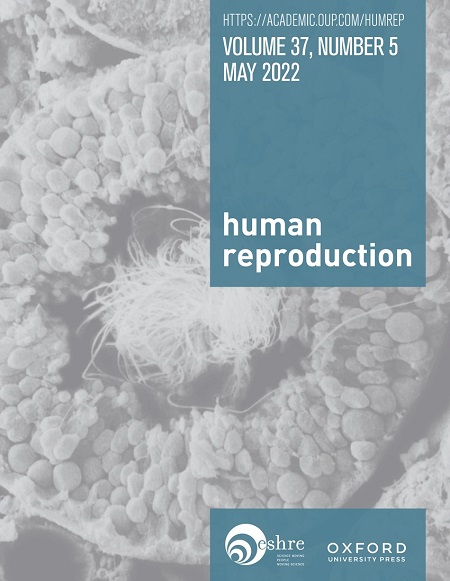Permanently infertile couples and family building-a cross-sectional survey in Denmark.
IF 6
1区 医学
Q1 OBSTETRICS & GYNECOLOGY
引用次数: 0
Abstract
STUDY QUESTION Which decision-making factors influence family building among permanently infertile couples? SUMMARY ANSWER Ethical, legal, and financial considerations outweigh genetic relatedness in decision-making, favouring domestic gestational surrogacy, if this were possible, over international options. WHAT IS KNOWN ALREADY Permanent infertility affects 4-5% of people in the fertile age. Their family-building options include adoption, surrogacy, uterus transplantation, foster care, and intentional multiple parenthood. However, in most countries, including Denmark, legal barriers constrain these methods due to surrogacy restrictions, suspended international adoptions, and the experimental status of uterus transplantation. Despite existing research on surrogacy, adoption, and specific causes of permanent infertility, a significant gap remains in our understanding of how couples with permanent infertility make family-building decisions within these limited frameworks. STUDY DESIGN, SIZE, DURATION This cross-sectional study with 150 permanently infertile Danish participants was conducted from June to November 2023 using an online questionnaire. Multiple strategies, such as online forums, fertility clinics, hospital departments, and snowballing, were used to recruit a diverse sample. PARTICIPANTS/MATERIALS, SETTING, METHODS The study included couples aged 26-50 years facing permanent infertility due to the following primary causes: women without a uterus (15%), women with a non-functional uterus (47%) or women for whom pregnancy would be life-threatening (9%), male couples (16%), transgender partner couples (2%), and other causes (11%). The survey collected data on demographics, reproductive history, family-building choices, and communication strategies. Closed questions were analysed using descriptive statistics. MAIN RESULTS AND THE ROLE OF CHANCE Among 150 respondents, 41% had used transnational surrogacy, 27% adoption, 14% chose to remain childless, and 19% were undecided. Critical factors on family-building decisions were ethical, legal, and financial concerns which ranked higher than genetic relatedness. Despite the complexity of family building, most participants were open about their child's origin and received social support. If all family-building methods were legal and available in Denmark, domestic gestational surrogacy would be the preferred method, with uterus transplantation and remaining childless being least popular. LIMITATIONS, REASONS FOR CAUTION The sample size is relatively small, despite the use of a variety of recruitment strategies. Nevertheless, this has ensured a diverse cohort representing the different reasons for infertility and family-building choices. It is important to note that the strategies may have favoured individuals achieving parenthood. WIDER IMPLICATIONS OF THE FINDINGS The finding of our study reveals a notable gap between available family-building options in Denmark and the preferences of couples facing permanent infertility. These insights could be instrumental for organizations reviewing and developing family-building frameworks. Furthermore, for healthcare professionals guiding couples experiencing infertility issues in their attempts to build a family, an understanding of these preferences is essential to facilitate informed decisions about their future family plans. STUDY FUNDING/COMPETING INTEREST(S) The project was financed by the Independent Research Fund Denmark. The authors have no conflict of interest to declare. TRIAL REGISTRATION NUMBER N/A.丹麦永久性不育夫妇与家庭建设--横断面调查。
研究问题哪些决策因素会影响永久性不育夫妇的家庭建设?简要回答在决策过程中,伦理、法律和经济方面的考虑超过了遗传亲缘关系,如果可能的话,国内妊娠代孕比国际代孕更受青睐。他们建立家庭的选择包括领养、代孕、子宫移植、寄养和有意多育。然而,在包括丹麦在内的大多数国家,由于代孕限制、国际收养暂停以及子宫移植处于试验阶段等原因,这些方法受到法律障碍的限制。尽管已有关于代孕、领养和导致永久性不孕的具体原因的研究,但我们对永久性不孕夫妇如何在这些有限的框架内做出建立家庭的决定的理解仍存在很大差距。研究设计、规模、持续时间这项横断面研究于 2023 年 6 月至 11 月采用在线问卷调查的方式对 150 名丹麦永久性不孕参与者进行了调查。研究对象/材料、地点、方法研究对象包括因以下主要原因导致永久性不孕的 26-50 岁夫妇:无子宫女性(15%)、无功能性子宫女性(47%)或怀孕会危及生命的女性(9%)、男性夫妇(16%)、变性伴侣夫妇(2%)以及其他原因(11%)。调查收集了有关人口统计学、生育史、家庭建设选择和沟通策略的数据。在 150 名受访者中,41% 的人使用过跨国代孕,27% 的人采用领养,14% 的人选择不生育,19% 的人未做决定。影响建立家庭决定的关键因素是伦理、法律和经济问题,这些因素的排名高于基因亲缘关系。尽管建立家庭的过程很复杂,但大多数参与者对孩子的出身持开放态度,并得到了社会的支持。如果在丹麦,所有建立家庭的方法都是合法的,那么国内妊娠代孕将是首选方法,而子宫移植和无子女则最不受欢迎。不过,这也确保了样本群的多样性,代表了不孕不育的不同原因和建立家庭的不同选择。我们的研究结果揭示了丹麦现有的家庭建设方案与面临永久性不孕的夫妇的偏好之间存在着明显的差距。这些见解对于审查和制定家庭建设框架的组织机构可能会有所帮助。此外,对于指导不孕不育夫妇建立家庭的医疗保健专业人员来说,了解这些偏好对于帮助他们就未来的家庭计划做出明智的决定也是至关重要的。作者不存在利益冲突。
本文章由计算机程序翻译,如有差异,请以英文原文为准。
求助全文
约1分钟内获得全文
求助全文
来源期刊

Human reproduction
医学-妇产科学
CiteScore
10.90
自引率
6.60%
发文量
1369
审稿时长
1 months
期刊介绍:
Human Reproduction features full-length, peer-reviewed papers reporting original research, concise clinical case reports, as well as opinions and debates on topical issues.
Papers published cover the clinical science and medical aspects of reproductive physiology, pathology and endocrinology; including andrology, gonad function, gametogenesis, fertilization, embryo development, implantation, early pregnancy, genetics, genetic diagnosis, oncology, infectious disease, surgery, contraception, infertility treatment, psychology, ethics and social issues.
 求助内容:
求助内容: 应助结果提醒方式:
应助结果提醒方式:


